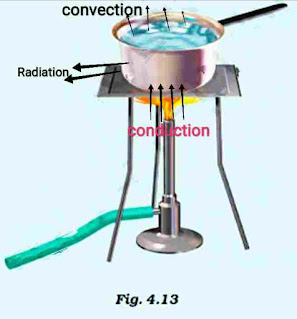NCERT Solutions Class 7 Science Chapter 4 Heat
NCERT Solutions Class 7 Science Chapter 4 Heat
This post will help class 7 students get an exact idea about class 7 science chapter 4 heat. This chapter is one of the most important chapters in NCERT solutions for class 7 science. The right idea about the Heat chapter, will help the students to get good marks.
Question 1:
State similarities and differences between the laboratory thermometer and the clinical
thermometer.Answer 1:
Similarities:
(i) Both are used to measure temperature.
(ii) Both have a thick walled glass tube enclosing a fine uniform bore capillary tube.
(iii) Mercury is used in both thermometers to measure temperature.
(iv) Both contain Celsius scales on the glass tube.
Differences:
NCERT Solutions Class 7 Science Chapters:
- Nutrition In Plants
- Nutrition In Animals
- Fiber To Fabric
- Acid Base And Salt
- Physical And Chemical Changes
- Weather Climate And Adaptations Of Animals To Climate
- Winds Storms And Cyclones
- Soil
- Respiration In Animals And Plants
- Transportation In Animals And Plants
- Reproduction In Plants
- Motion And Time
- Electric Current And Its Effects
- Light
- Water A Precious Resource
- Forests Our Lifeline
- Wastewater Story
Ncert Solutions For Class 7 Science
Question 2:
Give two examples each of conductors and insulators of heat.
Answer 2:
Conductors: Metals like copper, aluminum and iron.
Insulators: Wood, water, plastic, rubber, and air.
Question 3:
Fill in the blanks:
(a) The hotness of an object is determined by its __________.
(b) Temperature of boiling water cannot be measured by a _____________ thermometer.
(c) Temperature is measured in degree ______________.
(d) No medium is required for transfer of heat by the process of __________.
(e) A cold steel spoon is dipped in a cup of hot milk. It transfers heat to its other end by the process of ______________.
(f) Clothes of ______________ colours absorb heat better than clothes of light colours.
Answer 3:
(a) The hotness of an object is determined by its temperature.
(b) Temperature of boiling water cannot be measured by a clinical thermometer.
(c) Temperature is measured in degree Celsius.
(d) No medium is required for transfer of heat by the process of radiation.
(e) A cold steel spoon is dipped in a cup of hot milk. It transfers heat to its other end by the process of conduction.
(f) Clothes of dark colours absorb heat better than clothes of light colours.
Question 4:
Match the following:
Answer 4:
Question 5:
Discuss why wearing more layers of clothing during winter keeps us warmer than wearing one thick piece of clothing.
Answer 5:
There is a gap between two layers of clothes. Air is present in this gap. Air is an insulator of heat. This layer prevents our body heat from escaping into the surroundings. Now, more layers of clothes means more layers of air. So, very little heat is lost by our body. So wearing more layers of clothing during winter keeps us warmer than wearing one thick piece of clothing.
Question 6:
Look at Fig. 4.13. Mark where the heat is being transferred by conduction, by convection and by radiation.
Answer 6:
Question 7:
In places of hot climate, it is advised that the outer walls of houses be painted white.
Explain.
Answer 7:
White colour is a good reflector of heat. It means, white colour absorbs very little amount of heat. So, when we painted the outer walls of a house with white colour, very little heat entered inside the house. So, the temperature inside the house does not increase very much. In places of hot climate, it is advised that the outer walls of houses be painted white.
Question 8:
One litre of water at 30°C is mixed with one litre of water at 50°C. The temperature of the mixture will be
(a) 80°C
(b) more than 50°C but less than 80°C
(c) 20°C
(d) between 30°C and 50°C
Answer 8:
(d) between 30°C and 50°C
Question 9:
An iron ball at 40°C is dropped in a mug containing water at 40°C. The heat will
(a) flow from iron ball to water.
(b) not flow from iron ball to water or from water to iron ball.
(c) flow from water to iron ball.
(d) increase the temperature of both.
Answer 9:
(b) not flow from iron ball to water or from water to iron ball.
Question 10:
A wooden spoon is dipped in a cup of ice cream. Its other end
(a) becomes cold by the process of conduction.
(b) becomes cold by the process of convection.
(c) becomes cold by the process of radiation.
(d) does not become cold.
Answer 10:
(d) does not become cold.
Question 11:
Stainless steel pans are usually provided with copper bottoms. The reason for this could be that
(a) copper bottom makes the pan more durable.
(b) such pans appear colourful.
(c) copper is a better conductor of heat than the stainless steel.
(d) copper is easier to clean than stainless steel.
Answer 11:
(c) copper is a better conductor of heat than the stainless steel.
Introduction to NCERT Solution Class 7 Science Chapter 4 Heat:
This class 7 science chapter 4 discusses heat and temperature measurement in particular. Here we find questions about clinical thermometers and laboratory thermometers. Also find the differences between them. This chapter discusses various questions related to heat and temperature and their differences. In this ncert class 7 science, we will look at the questions of conductors and insulators and their examples. Here with the help of fill in the blanks, students can check the knowledge about this chapter.



